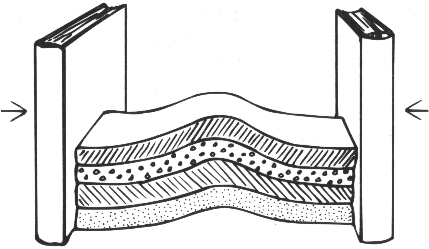
Click here for a printable version
Title: Mountain Building
Level: Middle
Time: 30 Minutes

Objective:
Visually demonstrate how rocks within the earth can be folded creating anticlines and synclines below the surface and mountains and valleys on the surface.
Materials:
Activity:
Discussion:
Sedimentary rocks are formed from deposits of mud, silt or sand at the bottom of the sea. The rocks form in horizontal layers much like the layers of Plasticine you constructed. Powerful forces in the Earth push on the rock layers. After millions of years have gone by, the rock layers fold, much like the Plasticine did.
The arch of the Plasticine fold represents an anticline, which could be the top of a mountain. The upside down arch of the fold, the trough, or syncline could represent a valley. Later, rivers or glaciers erode the land surface to sculpt new valleys and hillsides. Old mountains are the remnants of once larger uplifts and can contain both synclines and anticlines. Old valleys are where the rocks were softer and easier to erode.
Adapted from EarthNet activities